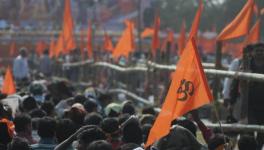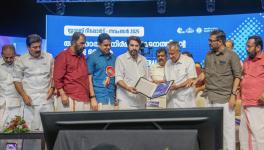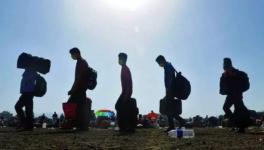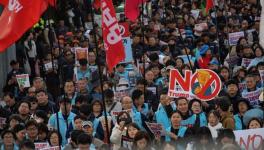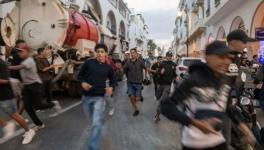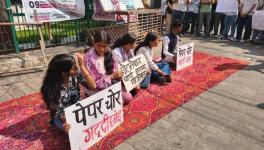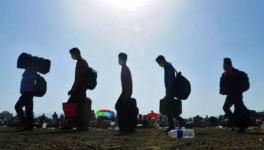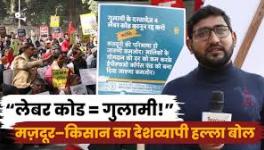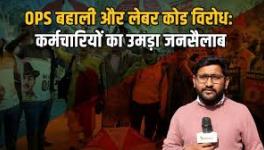COVID-19: In the Land of a Heartless Lockdown
Prime Minister Narendra Modi expectedly announced an extension to the countrywide lockdown till May 3 in yet another speech to the country on Tuesday. He argued that India had managed to beat back the deadly coronavirus pandemic till now due to the three weeks long lockdown and other measures, and urged yet more “restraint, penance and sacrifice” from Indians.
How much the three-week lockdown helped in stopping the pandemic in India has been analysed elsewhere in NewsClick, as also how essential is a lockdown as a strategy, considering many other countries (including China) never had one.
There is another dimension of the lockdown, however, that has been brushed under the carpet by the Modi government and the urban elite. It is the impact of such lockdowns on the people, the sudden yanking away of income sources, the empty grain stores, the inability to pay for common items, even if available, the loss of jobs, and the looming uncertainty of the future weeks, as things look like worsening.
How was this human dimension handled during the first three weeks? And has any amends been made, lessons learnt for the coming days till May 3? These questions have split the country into a well known divide – the class divide. While the well heeled and well stocked sections of people are full of passionate intensity for continuing the lockdown, irrespective of all the pain it is causing, working people of all kinds favour a better approach, which gives as much importance to their earnings and hunger as to saving them from the virus.
Sheer Indifference to People’s Livelihoods
Partial estimates put the joblessness rate at nearly 24%, as estimated by the Centre for Monitoring Indian Economy (CMIE). Nearly 50 million short-term migrant workers have lost their work and over one million migrant labourers are stuck in shelter homes far from home, according to an affidavit filed in the Supreme Court. Although a slew of relief measures for the poor people were announced both by the Centre and state governments, they are highly inadequate and there are huge gaps, preventing these measures from reaching those who need it. The Modi government admitted in the Supreme Court that in 13 states, NGOs provided food to more people than the state governments. Most migrant and rural workers are likely to descend into even harsher poverty. In urban areas, lakhs of formal and informal sector earners – whether employed by others or self employed – have suffered a catastrophic loss of income. The government’s feeble attempts to use funds from Employees’ Provident Fund and other such sources to somehow deliver some measly amounts to people through cash transfers have not been efficient, nor are they sufficient. Meanwhile, the government is reportedly readying plans to increase the working hours in a day to 12 hours to boost production with a smaller workforce. That means a death knell for a large number of workers and also immense losses and onerous exploitation for those who do work. And of course, they are pushed to exposure to COVID-19. But then, the government is doing this at the behest of big businesses, and workers are expendable.
Meanwhile, the Right To Food Campaign has compiled reports of at least 45 deaths, which includes deaths due to hunger, exhaustion and accidents of people walking back to their homes, police atrocities, inability to access medical services and suicides. Poor people are struggling to get food even from the PDS shops since supplies are erratic and many do not have ration cards. Along with the migrant workers and rural poor, urban slum dwellers across states are struggling to get access to food and ration as often they do not have ration cards. The Modi government announced that poor people would get 10 kg of rice or wheat, and 5 kg of pulses. According to the latest PIB statement, a total of 2 million metric tonnes of food grains have been unloaded by the states during the lockdown. But the government data shows that there was a surplus of 77 million tonnes with the Food Corporation of India. Pulses are also available in NAFED [National Agricultural Cooperative Marketing Federation of India] stocks, but they are unable to transport them to the needy. In fact, food should have been distributed across the board to everybody, as demanded by the Right to Food Campaign and the Jan Swasthya Abhiyan, irrespective of whether they have a ration card, with 10 kg of grain, 1.5 kg pulses and 800 gram cooking oil per month per person for at least six months.
Also read: What is a Lockdown all About Anyway?
The state governments are at the forefront of the struggle to look after the people because the Modi government has only been making sweeping declarations, leaving the former to implement them. But the already cash-strapped state governments are struggling to do the job. The central government has notified the release of Rs 11, 092 crores to the states under the State Disaster Risk Management Fund for combating COVID-19-related relief measures. However, the state wise distribution of the funds shows that there is discrepancy in allocation if determined on the basis of the number of COVID-19 cases. Maharashtra with the highest number of cases has been allocated Rs 1,611 crores, while Kerala which had the second largest number of cases till April 3 received only Rs 157 crore.
Healthcare System Still Not Ready
One rationale for having a lockdown was to allow time to boost the healthcare system’s preparedness to meet the pandemic challenge. What has happened on that front?
According to the Jan Swasthya Abhiyan analysis, 33 companies are approved for getting the rapid antibody testing kits that can do a test for just Rs 400. As per latest reports, orders have been placed but consignments (mostly from China) are delayed due to quality testing and also procedural delays. Besides these, some 27 PCR kit suppliers have been approved mostly from abroad. The actual supply is unknown. JSA says that the need for the future is unclear but may be “upward of 10 million test kits” per year. Given this scale of need, the Modi government is way behind in procurement. Hence, testing is very poor.
The Modi government botched up the testing procedure by first announcing that private entities could charge Rs 4,500 per test – something that was too exorbitant and a clear sign of bias towards the private sector avarice. When the Supreme Court intervened to take the other extreme and ordered free testing, the government is now thinking of reimbursing the private entities, something they could have thought before. The number of labs doing testing for COVID-19 is now reported to have increased to 223, of which 157 are in the public sector, and 66 in the private sector. Daily testing rates were low but now have reached about 15,000 per day. With this low level of testing, it's impossible to even know how much the disease has spread.
The government’s statements indicate that orders have been placed for 1.74 crore PPE sets and N95 masks. Till this happens, the huge shortage in N95 masks, coveralls and other PPE will continue, and health workers will continue to suffer themselves, and even become a source of transmission as happened in Bhilwara.
Most orders for PPE (34 out of 39), were placed only after announcement of the lockdown, a full two months after COVID-19 made its appearance in India, and 24 of these were placed in April 2020, JSA has pointed out. Deliveries, both imports and domestic, are lagging far behind the orders, production against some of which has barely begun. The government has announced that it has placed orders for 49,000 ventilators. The exact delivery dates are uncertain. A six-fold increase in supply of oxygen purchases is reported since February 1, but there is no news on oxygen concentrators.
Although government statements say that a large number of designated hospitals, isolation beds and ICU beds are ready, JSA has pointed out that there is no corresponding increase in the number of health personnel, minor equipment, major equipment, and skills. “Moreover, this threatens to have a crippling impact on provision of other routine essential health services, especially in the tertiary level public hospitals,” JSA said in a statement.
So, in sum, the first three weeks of the lockdown were an unmitigated disaster as far as the lives and livelihoods of common people are concerned, and adequate preparation for meeting the coming challenge of the pandemic victims too has not been done yet. Perhaps, the time (till May 3) will be better utilised than the past three weeks. Perhaps it will be worse. We will know by May 3.
Also read: Ahead of Monsoons, Lockdown Delays 122 Flood Control Project Works in Bihar
Get the latest reports & analysis with people's perspective on Protests, movements & deep analytical videos, discussions of the current affairs in your Telegram app. Subscribe to NewsClick's Telegram channel & get Real-Time updates on stories, as they get published on our website.










